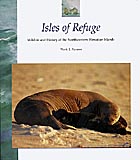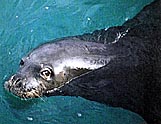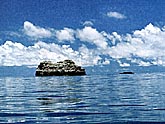By Ann M. Sato
Special to the Advertiser
 |
"ISLES OF REFUGE: Wildlife and History of the Northwestern Hawaiian islands"
By Mark J. Rauzon
University of Hawai‘i Press
$60 hardback
$29.95 paper |
Once there was a Hawaiian Island where Japanese "feather raiders," serving the millinery trade, took 284,000 birds in a single, short expedition.
Once there was a Hawaiian Island that supplied a Kalihi fertilizer factory with tons of phosphatized lime made from bird guano, chemicals that enriched plantation soil.
Once there was a Hawaiian Island where people lived in cliff-fronted caves and carved mysterious moon-faced images unlike anything found anywhere else in the chain.
These are the little-known Northwest Hawaiian Islands, 10 various-sized islands and atolls flung across 1,100 miles in the North Pacific, the most isolated fleet of islands in the world, 2,500 miles from the U.S. Mainland and 3,800 miles from Asia. The closest of these to the Hawaiian Islands we know is Nihoa, 135 miles northeast of Kaua‘i.
"Isles of Refuge," by U.S. Fish and Wildlife Service scientist Mark J. Rauzon, tells the story of these specks of land, the most isolated fleet of islands in the world, 2,500 miles from the U.S. Mainland and 3,800 miles from Asia.
 |
| A monk seal swims off Tern Island.
Photo by Mark J. Rauzon |
The book was released late last year, just as a team of scientists was returning from the recent Northwest Hawaiian Islands Expedition, sponsored by a consortium of government groups and including scientists from the Bishop Museum, which piqued many people’s interest in this part of Hawai‘i that few know, and few will ever see.
But Rauzon’s book is far from dry science. The Californian has the soul of a poet and his openness to self-disclosure causes the book, in parts, to read more like an adventurer’s journal than a scientific history. He also provided the book with its revealing photographs and the occasional beautiful watercolor sketch.
Rauzon skillfully gives us a sense of how difficult these treks to the Northwest Islands can be: landing on Necker, he says, "is like jumping off a moving elevator." He tells of wet nights in sleeping bags out in the open, of bird ticks that pester scientists struggling to eradicate grassy pests on Laysan, of tricky landings and rough seas. But throughout, he communicates the joy the various scientists feel who are privileged to visit these islands and to try to protect them. "A trip to Laysan is worth a week of seasickness, or two weeks," he writes.
At one point, he and UH professor Sheila Conant, a bird expert, are scrambling around Nihoa, covered with grit and salt after several weeks on the island, readying to leave. Stacking equipment on the rocky shore, they watch helplessly as a high wave carries off the box containing their only radio. And they laugh, agreeing that "this was the essence of life — to love nature without trusting it."
Beyond the human touch, the material itself is beguiling because it reveals a part of Hawai‘i’s history of which even many kama‘aina are unaware.
Everyone’s heard of the guano mining industry that laid waste to Nauru while enriching its people. Who knew that such a business thrived here, in the late 1800s and early 1900s, on Laysan Island?
We’ve all read of the efforts of Hui Malama and the various island burial councils to reinter ‘iwi — bones — to their rightful places of rest. But how many recall that just four years ago, a small expedition of Hawaiians, with Rauzon as the slightly uncomfortable representative of the Fish and Wildlife Service, chartered a ship to return bones to Nihoa and Necker Islands that had originally been collected by Bishop Museum archaeologist Dr. Kenneth Emory during the historic Tanager expedition of 1924?
 |
| La Perouse Pinnacle resembles a ship from a distance.
Photo by Mark J. Rauzon |
Rauzon writes eloquently of the strange mixture of discomfort and pride he experienced during this trip: discomfort, because he feels an outsider, a California haole among the Hawaiians; pride, because he feels himself to be completing the full circle of scientific exploration on behalf of his late mentor.
We know that the early Polynesians were great explorers and skilled navigators. But do we know that the eight "high islands" that we think of as Hawai‘i are not the only places where these early people lived? Rauzon describes a trip to the "biological paradise" of cliff-hung Nihoa, where early occupants resided in caves carved into the heights, and terraced the land to plant crops. Today, Nihoa is home to 485 species of insects and spiders, about 100 of them indigenous, and many of them found only in that one, small spot.
We know that Queen Lili‘uokalani was an intrepid traveler, who loved to visit her people and the Islands’ scenic spots. But how many know that she traveled in 1885, as a princess, to Nihoa with a large party who ransacked the place for birds, skins, eggs and feathers, lunched heartily, then had to literally swim for it when a couple of launches swamped and couldn’t get in to pick them up? (Lili‘u modestly donned her bathing costume before entering the waves.) "If the party had been all foreigners some would have drowned," the Advertiser reported at the time.
Stories like these tempt the reader along but the true heart of this book, and Rauzon’s true heart, is with the islands themselves and the damage that’s been done, and is being done, to them by human interference.
First, there were the guano miners, seal hunters and feather raiders who destroyed the landscape, wiped out entire species and brought foreign plants, animals and insects.
Then came military occupation and war, with depradation that ranged from bombing and building to scaring off mating monk seals.
Fishermen followed, scooping up lobsters literally by the ton and disturbing the animals’ reproductive cycle.
And finally, there are the rest of us, sending our junk out to sea to entangle and poison wildlife and foul beaches.
One photograph tells it all: a whimsical grouping of plastic creatures gathered from the sands of Laysan, carried there from the hands of Japanese children by the eastbound currents.
But he ends on a hopeful note, noting the work of scientists, the Fish & Wildlife Service, ecological organizations and others to restore and preserve the islands.
[back to top] |

 The Great Index to Fun
The Great Index to Fun

